“It is possible, by the mid-1990s, to eliminate sexual harassment, leaving a more productive and professional workplace for everyone.” That hopeful passage was in a 1985 book by Barbara A. Guteck, just as courts had started to concede that on-the-job harassment counted as discrimination. But judging by the direction of the courts, including the two Supreme Court decisions handed down today, that goal -- or, really, eliminating any kind of workplace harassment or discrimination -- seems more elusive than ever.
The decisions in Vance v. Ball State University (authored by Justice Samuel Alito) and the University of Texas Southwestern Medical Center v. Nassar (authored by Justice Anthony Kennedy) each watered down the ability for employees to sue under Title VII of the Civil Rights Act, which prohibits employment discrimination on the basis of "race, color, religion, sex or national origin." The first case, in which a kitchen employee of Ball State University said her co-workers had harassed her because she is black, narrowed the definition of a "supervisor" in determining whether an employer is responsible for harassment. (The central question was whether the harasser counted as a supervisor if he or she could assign responsibilities but not hire or fire someone.) The second, in which a doctor said he had been discriminated against for being of Middle Eastern descent and subsequently retaliated against, set a near-impossible standard for what constitutes retaliation after an employee complains he or she has been discriminated against.
Justice Ruth Bader Ginsburg, who made her name litigating sex discrimination cases, was plainly furious. (As she read her dissents today, Justice Alito apparently rolled his eyes and shook his head. In the meantime, Justice Clarence Thomas, the former head of the Equal Employment Opportunity Commission, reminded everyone in a concurrence that he thinks the concept of sexual harassment is a load of bunk.) "The court is guided neither by precedent, nor by the aims of legislators who formulated and amended Title VII," Ginsburg wrote in the Nassar case. "Indeed, the court appears driven by a zeal to reduce the number of retaliation claims filed against employers." In the Vance case, Ginsburg wrote, "Exhibiting remarkable resistance to the thrust of our prior decisions, workplace realities, and the EEOC’s Guidance, the Court embraces a position that relieves scores of employers of responsibility for the behavior of the supervisors they employ ... Inevitably, the Court’s definition of supervisor will hinder efforts to stamp out discrimination in the workplace."
As was occasionally suggested in response to the Fisher affirmative action case, the assumption that society is past the point where such protections are needed bears no relationship to reality. The problem has not gone away, at all: According to an amicus brief in the Vance case filed by the National Partnership for Women and Families (from which that optimistic quote about erasing sexual harassment comes), "Over the past decade, the number of charges filed with the EEOC and state and local fair employment practice agencies alleging harassment has grown by 25%. The number of charges filed with the EEOC each year alleging racial harassment is growing at an even faster pace, with an increase of over 31% in the last ten years. Women continue to suffer the brunt of sexual harassment, with women filing 84% of sexual harassment charges filed with the EEOC and state and local agencies."
Both of today's Title VII decisions come at a point where employees who are discriminated against already face incredibly daunting odds. Federal courts have become ever more hostile to those claims, at every point, which some experts believe is causing a chilling effect, with lawyers discouraging plaintiffs from even bothering to file a case that might be thrown out or won by the employer on appeal. An empirical study conducted in 2009 by Cornell law school faculty found many fewer such cases being brought, and when they were brought, "jobs cases proceed and terminate less favorably for plaintiffs than other kinds of cases. Plaintiffs who appeal their losses or face appeal of their victories again fare remarkably poorly in the circuit courts. The fear of judicial bias at both the lower and the appellate court levels may be discouraging potential employment discrimination plaintiffs from seeking relief in the federal courts." One example of an "anti-plaintiff" effect, they wrote, was how much more frequently employers won on appeal than employees did: "Defendants in the federal courts of appeals have managed over the years to reverse forty-one percent of their trial losses in employment discrimination cases, while plaintiffs manage only a nine percent reversal rate."
Or as one prominent employment discrimination attorney, Cyrus Mehri, told Salon earlier this month, “The doors are closing on people’s ability to vindicate their civil rights ... To some extent you had a judicial repeal of Title VII that hasn’t caught the public’s attention.” Thanks to the court's conservatives' twin decisions today, that "judicial repeal" is more profound than ever.



Shares